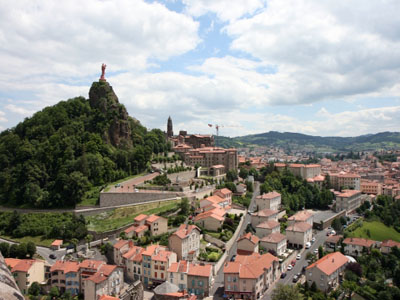Home ::Travel Destinations ::Le Puy
Le Puy

The Le Puy-en-Velay was a major bishopric in medieval France, founded early, though its early history is legendary. According to a martyrology compiled by Ado of Vienne and published in many copies in 858, which was supplemented in the mid-10th century by Gauzbert of Limoges, a certain priest named George accompanied a certain Front, the first Bishop of Périgueux, when they were sent to proselytize in Gaul. Front was added to the list of the apostles to Gaul, traditionally sent out to reorganize Christians after the persecutions that are associated with Decius and Gratian, circa 250. As with others of the group, notably Saint Martial of Limoges, later mythology pushed Saint Front and the priest George back in time, and tells how George had been restored to life with a touch of Saint Peter's staff. The expanding legend of this St. George, which, according to the Church historian Duchesne is not earlier than the eleventh century, then makes that saint one of the Seventy Apostles of the Gospel of Luke, and tells how he founded the church of the que dicitur Vetula in pago Vellavorum— as Ruessium began to be called during the fourth century: the city "called Vetula in the pays of the Vellavi" a document of 1004 termed it. Vetula means "the old woman": pagans were still making small images of her as late as the sixth century in Flanders, according to the vita of Saint Eligius. This was the first cathedral at the Le Puy.
The Christianization legends of Mons Anicius relate that at the request of the Bishop Martial of Limoges, Bishop Evodius/Vosy caused an altar to the Virgin Mary to be erected on the pinnacle that surmounts Mont Anis. Some such beginning of the shrine Christianized the pagan site that became the altar site of the cathedral of the Le Puy. It marked one starting-point for the pilgrim route to Santiago de Compostela, a walk of some 1600 kilom, as it still does today. The old town of the Le Puy gathered round the base of the cathedral.
The pilgrims came early to the Le Puy, and no French pilgrimage was more frequented in the Middle Ages. Charlemagne came twice, in 772 and 800; there is a legend that in 772 he established a foundation at the cathedral for ten poor canons, and he chose the Le Puy, with Aachen and Saint-Gilles, as a center for the collection of Peter's Pence. Charles the Bald visited Le Puy in 877, Odo, count of Paris in 892, Robert II in 1029, Philip Augustus in 1183. Louis IX met James I of Aragon here in 1245; and in 1254 passing through the Le Puy on his return from the Holy Land, he gave to the cathedral an ebony image of the Blessed Virgin clothed in gold brocade, one of the many dozens of venerable "Black Virgins" of France: it was destroyed at the Revolution, but replaced at the Restoration with a copy that continues to be venerated. After him, the Le Puy was visited by Philip the Bold in 1282, by Philip the Fair in 1285, by Charles VI in 1394, by Charles VII in 1420, and by Isabelle Romée, the mother of Joan of Arc in 1429. Louis XI made the pilgrimage in 1436 and 1475, and in 1476 halted three leagues from the city and went to the cathedral barefooted. Charles VIII visited it in 1495, Francis I in 1533.
 The legendary early shrine on the summit of the Mons Anicius that drew so many would seem to predate the founding of an early church of Our Lady of the Le Puy at Anicium, which was attributed to Bishop Vosy, who transferred the episcopal see from Ruessium to Anicium. Crowning the hill there was a megalithic dolmen. A local tradition rededicated the curative virtue of the sacred site to Mary, who cured ailments by contact with the standing stone. When the founding the bishop Vosy climbed the hill, he found that it was snow-covered in the month of July; in the snowfall the tracks of a deer round the dolmen outlined the foundations of the future church. The Bishop was apprised in a vision that the angels themselves had dedicated the future cathedral to the Blessed Virgin,
The legendary early shrine on the summit of the Mons Anicius that drew so many would seem to predate the founding of an early church of Our Lady of the Le Puy at Anicium, which was attributed to Bishop Vosy, who transferred the episcopal see from Ruessium to Anicium. Crowning the hill there was a megalithic dolmen. A local tradition rededicated the curative virtue of the sacred site to Mary, who cured ailments by contact with the standing stone. When the founding the bishop Vosy climbed the hill, he found that it was snow-covered in the month of July; in the snowfall the tracks of a deer round the dolmen outlined the foundations of the future church. The Bishop was apprised in a vision that the angels themselves had dedicated the future cathedral to the Blessed Virgin,
whence the epithet "Angelic" given to the cathedral of the Le Puy. The great dolmen was left standing in the center of the Christian sanctuary, which was constructed around it; the stone was re-consecrated as the Throne of the Mary. By the 8th century, however, the stone, popularly known as the "stone of visions," was taken down and broken up. Its pieces were incorporated into the floor of a particular section of the church that came to be called the Chambre Angélique, or the "angels' chamber."
It is impossible to say whether the St. Evodius is the same who signed the decrees of the Council of Valence in 374. Neither can it be affirmed that the St. Benignus, who in the 7th century founded a hospital at the gates of the basilica, and the St. Agrevius, the 7th-century martyr from whom the town of Saint-Agrève Chiniacum took its name, were really bishops. Duchesne thinks that the chronology of these early bishops rests on very little evidence and that very ill-supported by documents; before the tenth century only 6 individuals appear of whom it can be said with certainty that they were bishops of the Le Puy. The first of these, Scutarius, the legendary architect of the first cathedral, dates, if we may trust the inscription which bears his name, from the end of the fourth century.Adhemar, bishop of the Le Puy was a central figure in the First Crusade. The Pope Clement IV was also bishop of the Le Puy. Though the ancient bishopric was suppressed by the Concordat of 1801, it was re-erected in 1823.



